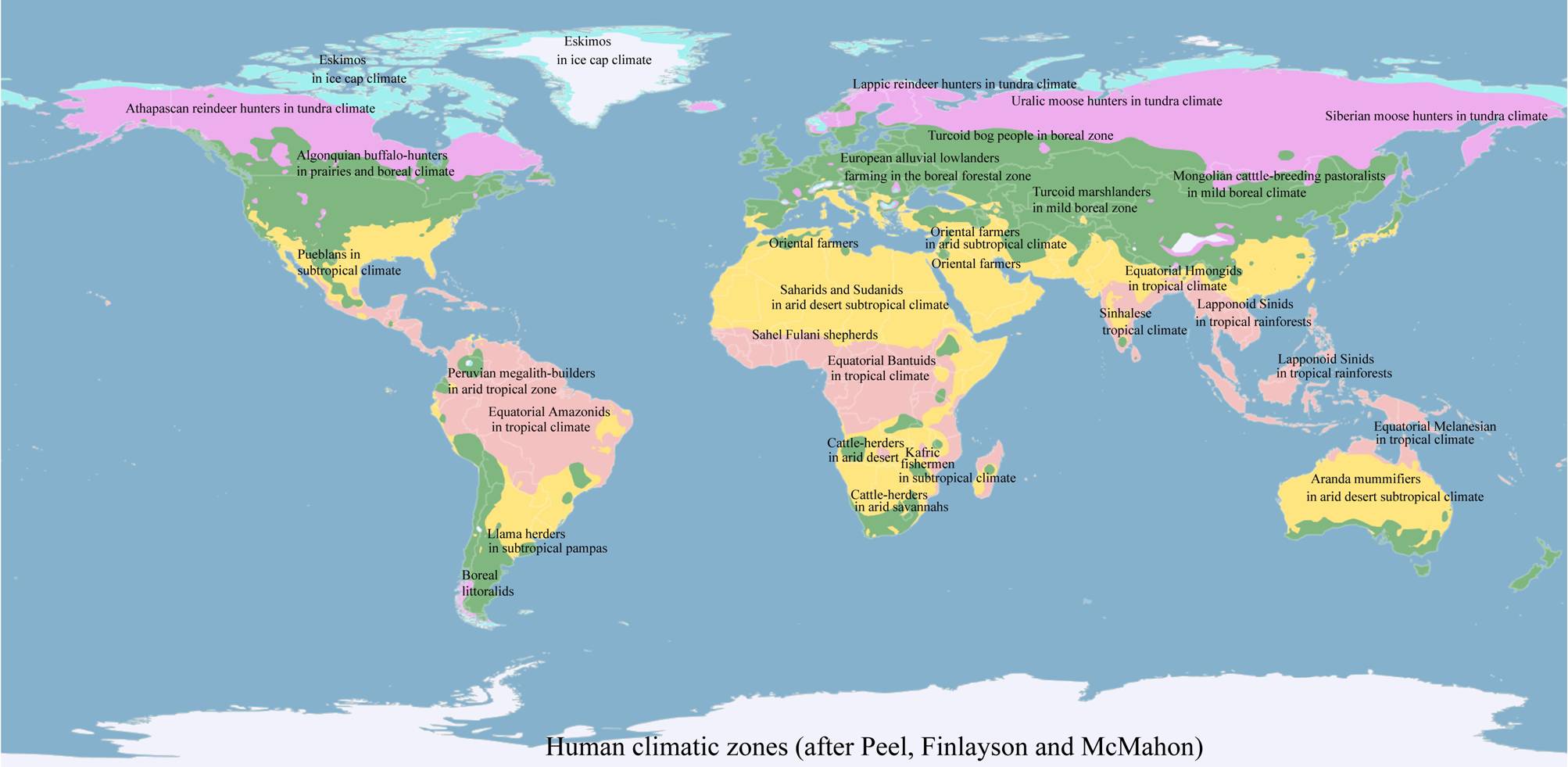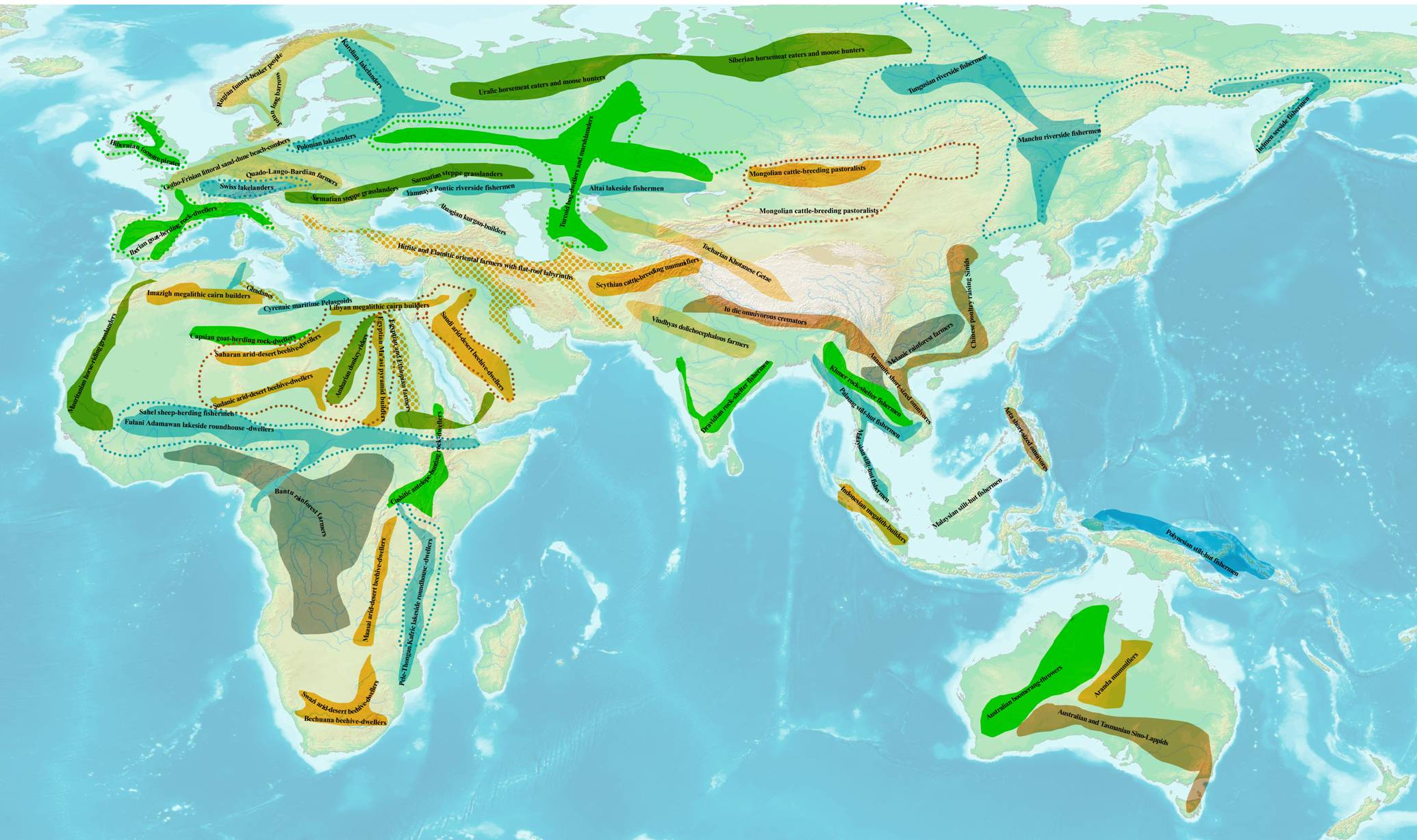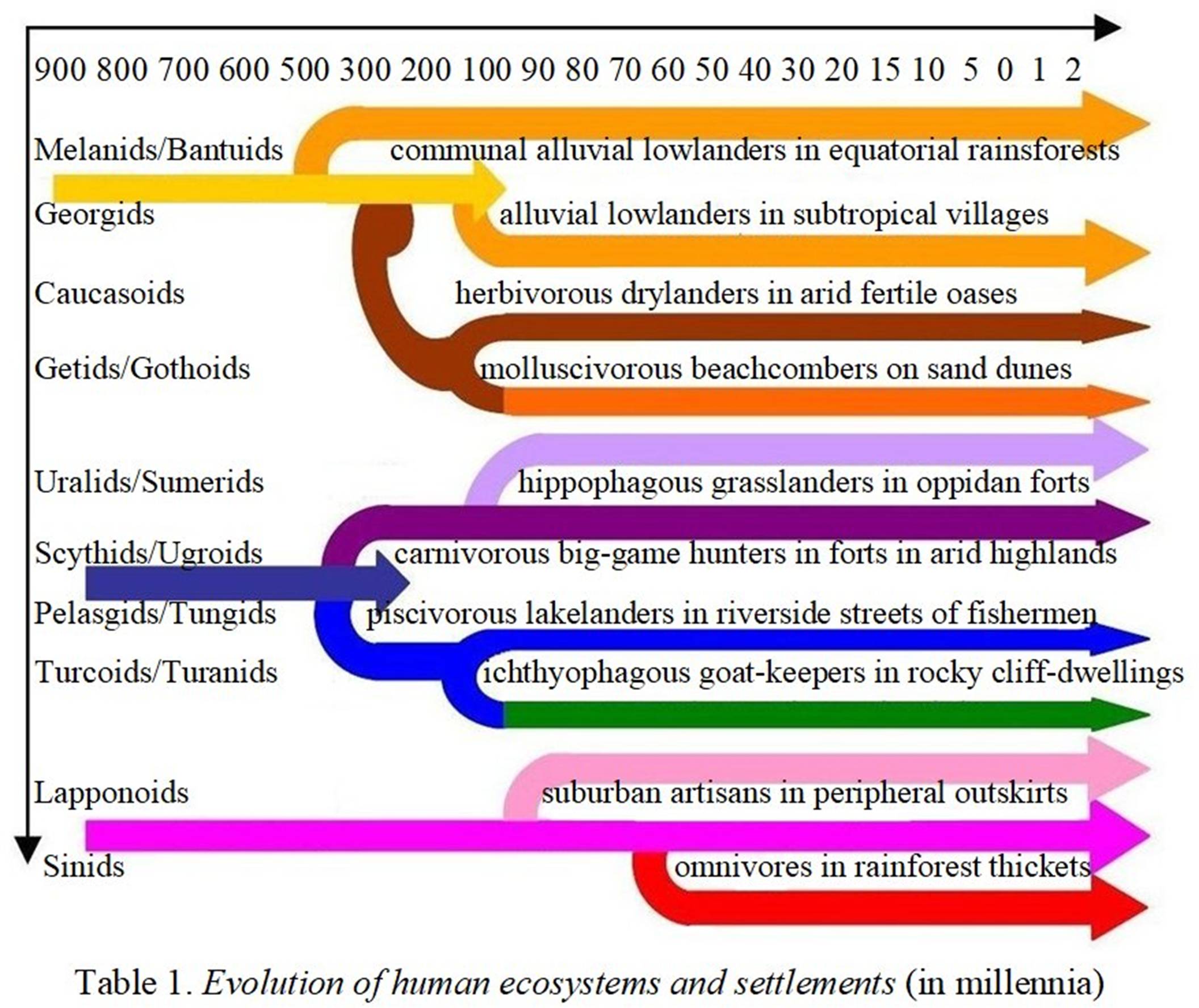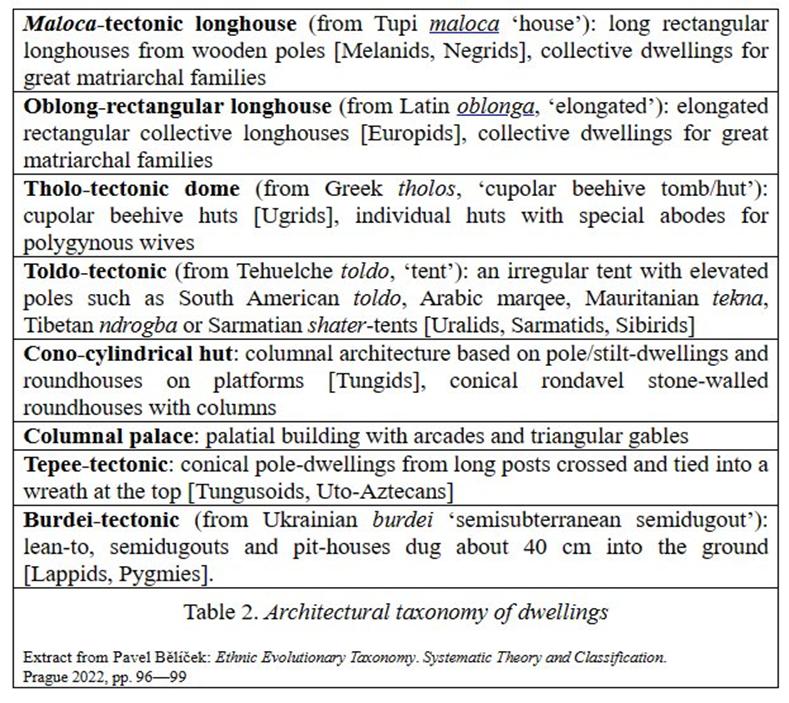|
|
|
||||||||||
|
|
|
||||||||||
|
|
|
|
|||||||||
|
|
|
|
|||||||||
|
|
|
|
|||||||||
|
|
|
||||||||||
|
|
|
||||||||||
|
|
Pathways of Ancient Folk Settlements and Human
Ecosystems Clickable terms are red on the yellow background |
|
|
||||||||
|
Map 1. Wordwide types of climatic zones
Map 2. Old World ecosystems |
||||||||||||||
|
|
||||||||||||||
GENERAL ARCHITECTONICS
§
Evolution
of human dwellings
§
Types
of huts and dwellings
§
Architectural
Taxonomy
§
Lakeside
Stilt-Dwelling with Crossed Poles
|
FOLK ARCHITECTURE §
Cliff-Dwellings
and Burial Rock-Cut Caves
§
Rectangular
Longhouses Out of Straw and Mud
§ Earth lodges and
Subterranean Sancturaries
§
Semidugout Zemlyankas
of Lapponoid Cremators
|
TYPES OF DWELLINGS
§
Tungusoids’ pile-huts,
stilt-houses and lake-dwellings
§ Pelasgoids’ conical rondavel roundhouses§
Megara, palatial
temples and columnal palaces
§
Flat-roofed
labyrinth architecture of Oriental farmers
§
Rectangular wicker longhouses with thatched
roofs
§
Gotho-Frisian
wurts, terps and half-timber longhouses
§
Dome-shaped beehive huts
§
Pile-dwellings
§ Bascoid Cyclopean megalithic architecture
§ Megalithic tombstones
and tholoi graves
§
Lapponoids’ lean-to and semidugout pit-house
§
Turcoids’
dwellings and burials in rockcut caves
|
ANCIENT SETTLEMENTS §
Multicellular
Labyrinths in Lowland Valley Villages §
Tell-sites §
Oppidans:
Hillforts Towering on High Rock Promontories §
Boroughs §
Palatial Poleis
and Cultic Spas in Seaside Harbours §
Straight Streets
and Alleys of Lake-Dwellings |
|||||||||||
|
The Architecture
of Traditional Indigenous
Houses Man
protects himself from adversities of the weather and climate in different
geographic zones by dwellings. If ABO groups represent a trans-species
phenomenon uniting humans with primates, dwellings, surprisingly, provide a
trans-continental criterion of comparison. Their patterns seem to be ‘trans-chronical’
because architectural archetypes seem to have persisted since Palaeolithic
times up to now and modern indigenes. For instance, dome-shaped beehive
dwellings unite Swazi people, Khoids, Maasai tribes, Berber and Basque funeral
architecture, Irish or Scottish megalith-builders, Algonquian
wigwams and Peruvian Quechua habitations. Their origin from Mousterians is
demonstrated by Molodovo mammoth-bone huts and Eskimo whale-bone huts in
Greenland. Mutual differences were removed by cave dwellings occupied by
boreal hunters in wintertime. The following ordered chains do not sketch
direct transitions but suggest stages that apply also to parallelisms in
premortal and postmortal abodes: straw beehive hut
> stone clochán and cairn > cupolar mosque
dome > citadel; Khoisan
heap-stone tomb > Berber tumulus > Mycenaean tholos >
pyramid; post-dwelling
> rondavel roundhouse > conical tepee > columnal palace; collective oblong longhouse >
Amazonian maloca > Gothic half-timber wurt. They demonstrate that evolution does not
switch from one typological archetype to another but observes laws of
inheritance that preserve genetic continuity pursuing one characteristic
tradition. Such continuity links prehistoric tents with medieval folk huts
and royal residences of monumental architecture. This means that cultural
development proceeds forth in several independent lineages along different
paths. Table 1 employs square brackets for tribal groups so as to indicate
ethnic appurtenance.
Table 1. Types of huts and
dwellings |
Architectural
Taxonomy
|
|||||||||||||
|
|
Auxiliary
Criteria of Architectural and Ceramic Ethnology
The racial and ethnic identification
cannot be guided only by the present-day phenotype appearance, its analysis
has to trace back archaeological roots, explore geographical distribution and
compare also typological chains in several prehistoric disciplines. Map 4
demonstrates that Africa is occupied by at least three related
dolichocephalous racial stocks with similar osteology, craniology and
housing: autochthonous African Negrids, Caucasoid Ethiopids and Nordic
Littorids. Their skeletons show tall stature, platycnemia betraying
terrestial open-air ecotype and upright gait but share similar traits also in
collective life-style, clothing, architecture and housing. Moreover, they
seem to be correlated also by analogous inclinations to axe-tool making
industry, vegetal and plant-gathering subsistence, rectangular longhouses,
matrilocal endogamous marriage, dowry and theocracy. Map 4 shows three principal streams of
axe-tool makers, who descended from the African continent but later returned
back to its heart. All factions of Negrids originally cohabited in large
matrilinear families and built quadrangular timber huts filled by clay. Their
shape was roughly similar to large longhouses inhabited by the Danubian
peasants of the Neolithic Linear Culture or collective house maloca of
the Tupí-Guaraní tribes in Amazonia. The common denominator of all Negrids
consisted in wearing fringed grass aprons and the custom of grown-up women to
go out bare-breasted in a topless dress. Fringed grass aprons form an
indispensable accessory of clothing in Melanesia, Polynesia and Amazonia.
Their design was clearly discernible also in paintings of ancient
Mesopotamian Gutii, ‘Ubaidan
peasants and Cretan goddesses. The chief duty of their females was to bring
water in gouged wooden vessels on their head. Another typical utensil was a
head-bench for resting and sleeping. External influences from Eurasia were
visible in Caucasoid Etiopids and Atlantic Littorids. The Acheulean Ethiopids
accomplished an architectural revolution by replacing wooden logs by clay and
rammed pisé on account of lack wood in arid desert regions. They began
to build multi-cellular many-roomed houses out of sun-dried bricks. They had
flat roofs, firm external walls and few outer windows. In fear of alien
intruders, they were usually accessed on removable ladders from above. Their
architectonic style was favoured by farmers and townsfolk in Ethiopia, Egypt,
Libya and Algeria. The hybrid composition of African Nordids and Caucasoids
out of heterogeneous layers should not make us blind to their specific new
peculiarities. Their ethnic heritage shone through especially in the rites of
bull cults and bull fighting. They settled down in fertile areas along the
reaches of water streams but they did not despise colonising arid areas of
oases in deserts, either. The last but not the least of African races comes the ethnic
group of white-skinned Littoralids pursuing the western coast of Africa as
beachcombers as far as the South African Cap of Good Hope. The European Bell-Beaker Folk and African Littoralids
manufactured campaniform pottery with corded patterns and lived in huts that
were reminiscent of the Frisian three-aisled wurt. Their two-pitched
roofs were sloping down to the earth. The mysterious group of Atlantic
Littoralids with shell midden evolved from the Mesolithic Campignian culture
(10,000 BC). They were of Indo-European origin but differed from the Danubian
Europids with clear agricultural dispositions by living as shellfish eaters
relishing on molluscs, snails and frogs. These northern invaders were
probably responsible for the import of the West African sacred double-bitted
axe. The ancient Romans knew it as bipennis, the Greek Minoans called it labrys and Lydians
mentioned it as πελεκυς, pelekus.1 Its true copy was celebrated in
the mythology of African Yoruba people, who worshipped it as a symbol of the
god Sango or Xango. The early invasion of white-skinned Nordids into the African continent can be documented also by archaeological finds. Their hosts sailed along the western coasts of Portugal, Mauretania, Guinea and Angola as far as South Africa. They belonged to beachcombers classified as Littoralids, built their shelters on elevated sand-dunes and left behind characteristic heaps of shell midden (kjökkenmöddinger). Their roaming hordes may be denoted as Campignians affiliated to Frisians and the Mugem culture in Portugal. The southwest regions of Europe became their secondary homeland and served as the birthplace of Franco-Swabian tribes. In the Neolithic they developed a special cultivar of the Beaker-Folk culture with its typical bell-shaped pottery. It was probably the Portuguese Mugem shell-midden culture that ensured Frenchmen and Franco-Swabians the ill repute of frog-eaters. The ceramic morphology of the Spanish Bell-Beaker Folk retained its patterns also on African travels. It breathed life into the Campagniforme culture swaying in Guinea and Angola in the Neolithic period. Its spread may be responsible for a great number of Europoid toponyms and ethnonyms such as Cotonou, Ketou, Brass and Sasso in the Gulf of Guinea. The residual vestiges of the Bell-Beaker Folk Littoralid’s colonies can be recognised also in recent ethnic tribes. Bernartzik’s ethnographical survey mentioned them as hosts of conspicuously white-skinned indigenous tribes on the coasts of Angola.2 |
Such intercontinental similarities
witness that consanguine populations maintain genetic inheritance, cultural
endurance and long-range typological stability. Their inner affinity is based
on the common genetic outfit passed as a relay over hundred thousand years.
After Negrids pursued the fates of archaic Oldowan ancestrors they enriched
their cultural endowment by adding Sangoan and Lupembian innovations. On the
Arabian Peninsula they infiltrated into the northern boreal Asiatic races and
their mutual contacts gave rise to the mixed hybrid race of Acheulean
Caucasoids. Caucasoids flooded the Near East, Anatolia and South Asia and
took part in reforms of Neolithic agriculture. Their kinsfolk expanded also
backwards in the native African continent and created a new racial variety of
Ethiopids. Their northern mutations included European Neolithic farmers and
Campignian Littoralids, who combed the beaches of Atlantic seacoasts as far
as the Gulf of Guinea. Map 5 adds comparison between rectangular
housing types common to axe-tool cultures of African origin and tent
constructions characteristic of Afro-Asiatic tribes descending from the Near
East. The raids of Afro-Asiatic invaders are assumed to have created the
language families of Semitic,
Berber, Chadic, Cushitic, Egyptian and Omotic peoples.
The Arabic and Bedouin nomadic camel-breeders lived in irregular marquee
tents with several pitches supported by poles. Bedouins called them beit
al-sha’r, its Mauritanian form was denoted as tekna
and Tibetan herders knew it as ndrogba. The
Berber Imazhigen originally built huts and burials mounds resembling cupolar
or half-barrel shaped beehive constructions common among the Maasai and the
Khoisan Khoikhoi. But they looked like stonemade dome-shaped vaulted cairns,
whereas the cattle-breeding herders in the southern regions of Africa made
them out of boughs and straw. Cushitic settlers took over the architectonic
style of East African rondavels, i.e. the Pedi-Thongan roundhouses
with pointed conical roofs and cylindrical basement. Modern Herero and Damara
tribes live in conical huts with cylindrical understructure but their
Mesolithic progenitors preferred to dwell in rock shelters and articifical
rock-hewn-caves. They arrived to South Africa with the plantations of Wilton
culture colonists (5000 BC) and sketched petroglyphs and rock-paintings that
are erroneously attributed to Bushmen.
From Pavel Bělíček: The Differential Analysis of the Wordwide Human Varieties . Prague 2019. pp. 14-17 |
|
|||||||||||
2 H. A. Bernartzik: Die
neue grosse Völkerkunde. Wien – Prag 1962.


























